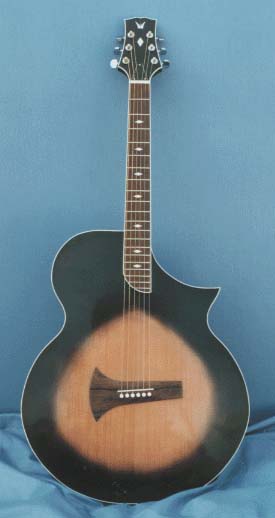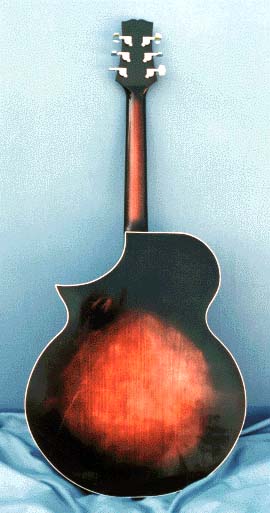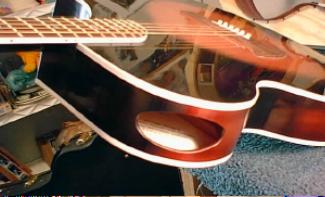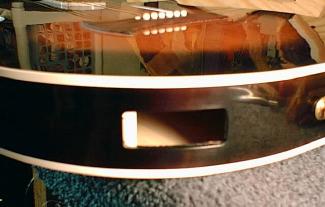Kasha Prototype

This was my first steel string Kasha model prototype.
I put a lot of time into coming up with a good design based on the published theories and articles
by Dr. Kasha. The guitar has a twelve fret
neck in order to put the bridge more in the center of the lower bout,
and a cutaway to allow access to the upper frets. I also wanted to
try an alternative wood that I had never used before since I had
some on hand that seemed to have a really nice tap tone. The body is
an 18" wide jumbo shape with a redwood top, brazillian
rosewood bridge and fretboard with tulip poplar used for the neck
and back/sides. If I had to describe the sound of the poplar, I would
say that it's sound characteristics are somewhere between the sound of mahogany and soft maple.
I really like some of the instruments that I have built in the
past with soundholes in the upper bout, so I decided to take this
idea one step beyond the upper bout placement in the top. I put the soundhole
in the side of the guitar in the upper bout area. This allows
the player to get more of the guitars sound. I also had some questions in my
mind about exactly how the frequency of the Helmholtz resonance
effects a guitars sound, so I built in an adjustable port in the lower bout
so that I could vary the frequency. It has a very interesting effect and can really vary the sound enough to make the guitar sound like two or three different guitars in one. When the port is opened all the way it is more bassy, and with it closed the treble and midrange is accentuated more. On closer inspection I have found that the actual pitch of the soundbox only raises 1/2 step when the port is fully opened (vs. completely closed) because the size of the port is small. The extra airflow is more responsible for the difference in sound, but I think there may be some sort of coupling going on between the soundhole and the port. I won't swear to that because I can't prove or disprove it, but there seems to be something going on there. One thing that is for sure, I have learned that the amount of air flow seems to have a lot more to do with varying the sound than the actual helmholtz freq seems to have.






© 1997 vin_designs@ftc-i.net









